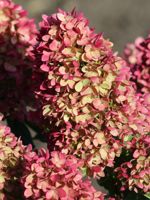Mon-Fri 9am - 5pm Mountain time
Black Elderberry vs Dragon Baby™ Hydrangea
Sambucus canadensis
Hydrangea paniculata HYLV17522
NOT AVAILABLE THIS SEASON - MIGHT RETURN
Black Elderberry is a deciduous shrub native to eastern North America. You can plant this shrub in moist areas and it will help stabilize your soil. You can also use it on rural properties anywhere you'd use a lilac.
Black Elderberries are considered to be partially self-pollinating. So while they will still produce some berries without cross-pollination, planting with another variety will increase yields. Consider planting with Ranch Elderberry or Bob Gordon Elderberry.
Warning: the seeds, stems, leaves, roots, and uncooked berries of the Black Elderberry are poisonous to humans when eaten in quantity. You should cook the berries to make them safe for human consumption.
Dragon Baby™ Hydrangea is a dwarf panicle hydrangea with flowers that start as lime green and transition to a rich pink towards the fall. During the summer the leaves are a deep green and turn a golden yellow with a red to purple tint. Persistent blooms and fall colors add multi season interest to your landscape. The petite form is well suited for urban yards and tight spaces.
Flowers grow on new wood so pruning is best done in late winter or early spring. The Dragon Baby Hydrangea is part of the Bloomin’ Easy® collection.
Black Elderberry Quick Facts
Dragon Baby™ Hydrangea Quick Facts
Toxicity: leaves, stems, and uncooked berries are poisonous to humans

